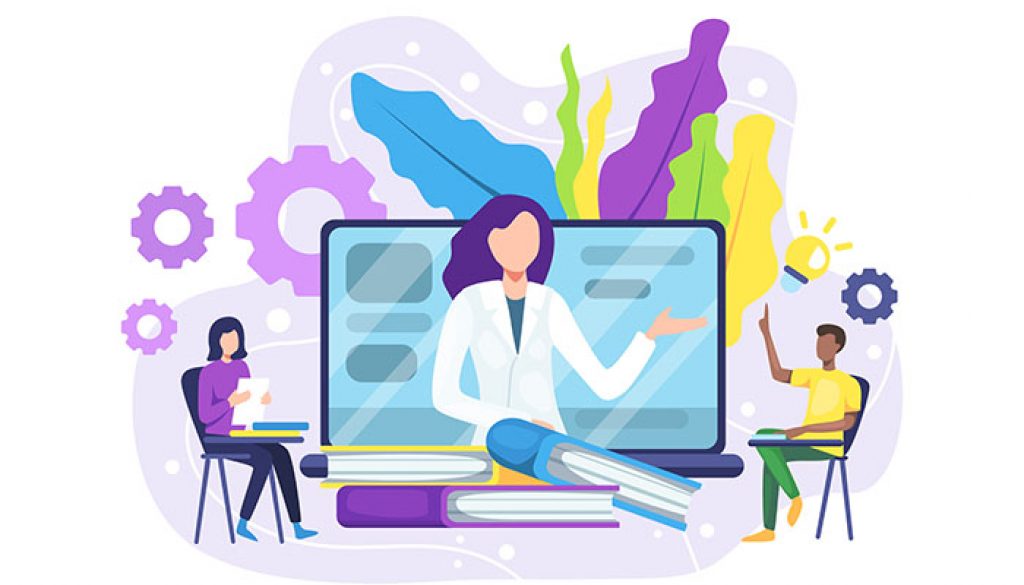WITH ONLINE ACTIVITIES, NETWORKING, AND REMOTE WORKING, THINGS HAVE STARTED TO GET BACK ON TRACK WHICH EMPOWERED EDUCATION SECTORS WORLDWIDE TO PROMOTE AS WELL AS ENCOURAGE REMOTE LEARNING WITH ONLINE TEACHING AS NEW NORMAL. RISE OF BLENDED LEARNING APPROACHES WITH THE ASSISTANCE OF DIGITAL TECHNOLOGIES AND SUPPORT SYSTEMS, LEARNING ALONG WITH TEACHING HAS ADAPTED INNOVATIVE, SUSTAINABLE, AND MUCH MORE RELIABLE WAYS TO DELIVER EDUCATION TO THEIR STUDENTS.
Is Blended Learning A New Concept/Norm?
Blended learning can also be defined as ‘hybrid learning’ and ‘multi-method learning’ which combines the inclusion of e-learning resources and tools with traditional methods of learning.
Though blended learning approaches brought back and link to some traditional concepts where it goes through self-directed learning phase like similar student-teacher interaction, when teachers used to;
- Structure, dictate, and present the content.
- Support the learner’s process.
- Creating Social learning environment.
Blended learning is not a much new concept. Educators always have used techniques and styles by combining available resources.
Indeed, it’s an approach integrating teaching and its facilitation methods, resource formats advanced learning styles with the help of a wide range of digital technologies and its expertise.
How blended learning has changed the traditional education system?
Traditional concepts of education are pretty much about student and teacher interaction under one roof, where teaching, as well as learning experiences, were bounded and happened to be synchronized within a physical location.
Presently, improvisation within the blended learning approaches has caused these experiences from beginners level to rose up to the next level succoring the interactions to becoming more meaningful and sustainable making effective use of e-learning tools.
With the integration of tech with education, trends can be noticed at almost all levels which have made receiving education more portable and convenient realizing the need of the hour.
It arouses curiosity to see how multi-device sync with software provides collaboration opportunity having multi-users within online and offline modes.
How Blended Learning is impacting educational development for a student?
Blended learning models have been developed in such a way by taking into consideration overall student’s development along with providing a better user experience.
These concepts provide online activities and interactive content through animation videos and quizzes to enhance a student’s intellectual capabilities. Students have the benefit to consume the content whenever they want, can understand at their own pace along with revising the content whenever they prefer to.
What helps students to become savvy with these learning approaches?
It becomes equally important for learners to interact and get involved with these approaches. Their backgrounds and characteristics are the elements that contribute to the effectiveness of the learning process. Chances are blended learning tools and technologies might influence that efficacy level.
A good learner management system helps blended learning models combine e-learning with class methodology techniques for students to experience and adapt to new modes of teaching.
What is the role of Modular Learning DepEd?
Modular learning DepEd is where students are provided with the self-learning materials (SLMs). They would be receiving 4 sets of SLMs for one academic year.
It is a form of distance education with the help of SLMs influenced by the Most Essential Learning Competencies (MELCS) provide by DepEd. The modules consist of a section of assessment and enhance motivation that becomes the guide stimulating teacher’s and student’s desired competencies.
Educators will be monitoring the progress of students and regarding feedbacks and home visits for specific assistance required.
What’s in for teachers and students adopting Modular Learning Model?
FOR TEACHERS –
DepEd encouraging modular learning system requires teachers to undertake a complex set of activities on an individual level as well as within a team. The role of an educator or teacher is to enhance and coordinate teaching programs through well-structured content via the most appropriate communication channel or medium.
FOR STUDENTS –
Learners receiving education via self-learning modules in the form of digital content/copy, materials, textbooks, activity sheets, study guides can get guidance with text or call, social media if a visit is not possible.
Students learning through offline mode can receive recorded sessions of online classes via USBs or CDs.
Parents and guardians are too playing equivalent roles as in being para-teachers or teacher’s assistant’s for delivering lessons to their children.
What are various blended learning approaches/models to choose from?
Well said, ‘Different approach/strategy for different student’. The same applies to blended learning. Let’s look at some –
Flexible Model
Student’s classes will be divided into three groups with starting three days of online sessions and another three days, different groups would attend physical classes where they can have their doubts cleared raised attending online classes.
Sleep Classroom
An approach where a study material would be converted to a video and be distributed a week earlier. After seeing the video, students can attend online classes to discuss that video lesson interacts with teachers to clear the doubts.
Collaborative Learning
This approach is applied with the assistance of Google Meet’s ‘White Board’ option where teachers and students use the tab as well as the teacher teaches on whiteboard besides students can also write the problem/queries on the whiteboard for teachers to solve them out.
Re-defining system
After the classes, students are given the assignment and asked to complete it in audio-video format to check and analyze to ensure that the student’s/learner’s practical knowledge understanding is grasped properly.

Rotational Classes
There is a rotation in online as well as physical classes, where one group attended physical classes on Monday, Wednesday, and Friday. The other group attends their physical classes on the remaining three days of the week. The surveillance records are kept through a classroom’s camera. If day, students aren’t having their physical class they can attend online classes.
Project-based learning
Students are being asked to make a project on the subject matter they’re studying to check their knowledge being received. Later, during the teacher’s and student’s interaction, improvisation tips or guidelines even problems can be discussed related to the project work.
Gamification
This turns out to be the most exciting approach/model for students where they’ve been told to complete their tasks in the form of games within given time slots. Seeking the time and measuring accuracy aspect they would be rewarded with points and prizes for retaining their interest and engagement level.
Online Practical System
Within the model, the software is developed to initiate practicals and students are being called into groups to do the important practicals. The same can be tracked for online practicals as well.
Opportunities and Challenges For Blended Learning.
Since last year, the educational sector and related people have faced problems including job security along with experiencing how technologies can shape and re-invent the future of teaching and learning.
Blended learning approaches have brought a ray of hope as well as some challenges in the way of fully utilizing these approaches. Let’s go through them.
CHALLENGES INCLUDE:
Absence of interaction between teachers and students.
Due to covid situation and shutting down of schools, education centers, physical interaction got lessened which somewhere has impacted the learning process and face-to-face communication.
Insufficient Training.
Educators and teachers have been unable to adapt to tech-based education with these models and delivering the same for their students. Not knowing the efficient use of tools and technologies to enhance learner’s experience has slowed down the pace of educating.
Choosing content for blended learning.
While experimenting with the new learning models comes a daunting task to develop and deliver the appropriate content along with evaluating whether it’s by the study requirement as well to ensure student’s engagement.
Expensive Technology within application of blended learning.
Another challenge and the biggest one can adopt and implement learning technology that could disturb the budget with related costs and expenses to maintain besides assuring its effective delivery.
Technical Issues.
While completing the course or studying online often issue like weak internet connection, inability to track attendance of students online interrupted delivery of contents arises and obstruct the flow.
Decreased Motivation with pacing up with blended learning approaches.
Sometimes students aren’t that motivated or feel enthusiastic about learning using new models because of a lack of communication and interaction and especially for those who prefer a physical study environment.
Teacher-Student Authenticity.
Self-learning models have affected authenticity as teachers sometimes might not be able to provide customized solutions for every part of the learning process.
OPPORTUNITIES INCLUDE:
Flexibility in timings.
Flexible timings make it easy to catch up with the learning process and can be assessed anytime which wouldn’t be possible with particular class schedules.
Uniform reach.
Content can be delivered and reached to national as well as international students through collaborative tools.
Administration of the learning process and content moderation becomes easy.
Meeting the content needs with suitable hardware and desired software requirements make the functionality and administering easy to manage.
No need to appoint additional faculties for blended learning models implementation.
The blended learning approaches and models are designed, have been developed in such a way that only a single teacher to provide benefit to students through enrolling many into the course.

Some interesting techniques for students to enjoy the learning process.
The Bottom Line
The importance of blended learning models would increase more with time and educational authorities will ensure its access to every student through various sources.
Getting aid from tech devices, e-learning involved with IT support has been encouraging students and teachers to become more mindful and support these new models of learning for their evolution.
Originally Published at : Artizone Information


